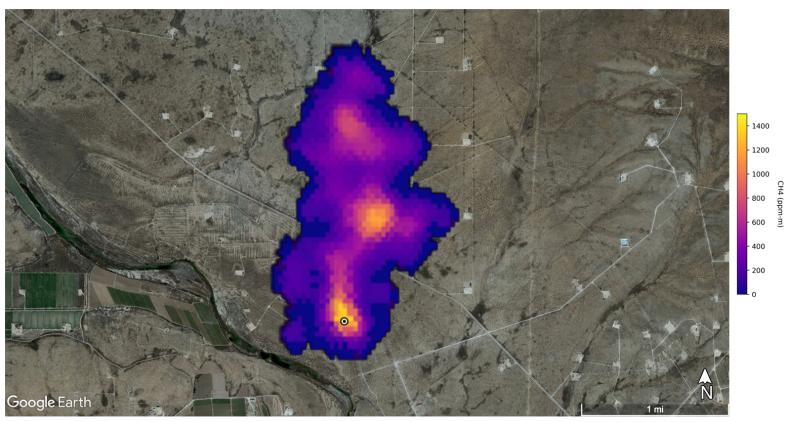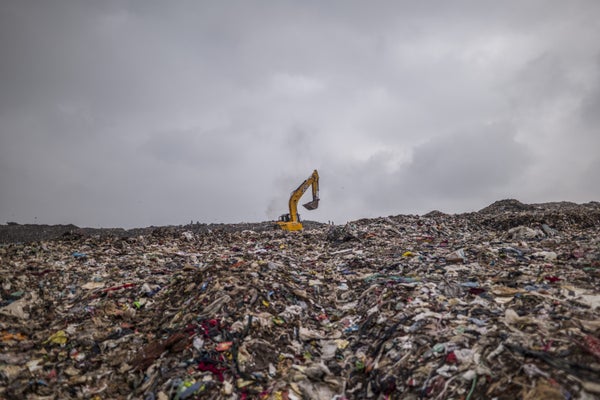An instrument recently installed on the International Space Station (ISS) is proving its mettle at spotting plumes of greenhouse gases that are altering Earth’s climate.
The sensor, called Earth Surface Mineral Dust Source Investigation (EMIT), was delivered to the space station in the summer of 2022. Its main purpose is to determine how dust in the atmosphere affects Earth’s climate. But it turns out this capability also enables EMIT to gather highly detailed observations of previously unknown plumes of the key greenhouse gases methane and carbon dioxide, according to new research that analyzed the instrument’s first 30 days of data. Scientists hope the ability to pinpoint emission sources can be a valuable tool in tackling the climate crisis as greenhouse gases reach ever higher concentrations in the atmosphere, as announced by the World Meteorological Organization this week.
The EMIT sensor is so valuable because it pairs the precision of technology such as airplane-mounted instruments with the wide coverage of satellites.
On supporting science journalism
If you're enjoying this article, consider supporting our award-winning journalism by subscribing. By purchasing a subscription you are helping to ensure the future of impactful stories about the discoveries and ideas shaping our world today.
“With a lot of the previous methods, you might get a sense of what’s happening in a broad region or a city, but it’s not always possible to attribute the emissions to, let’s say, this part of the city, this power plant, this landfill,” says John Lin, an atmospheric scientist at the University of Utah, who was not involved in the new study, published on Friday in Science Advances. “That type of attribution becomes quite useful, especially if we think about ways to reduce these emissions.”
EMIT has already spent more than a year watching Earth. These observations have prioritized monitoring dust, however—so the instrument has so far focused on particularly dusty regions such as northern Africa and Central Asia. As a secondary task, greenhouse gas sensing overall has taken a back seat; in the scant time available to date for emissions work, the team has prioritized studying methane over carbon dioxide because methane sources aren’t as well understood, according to mission personnel. That might change if NASA continues the mission into the new year and beyond, says EMIT’s principal investigator Robert Green, an Earth systems scientist at NASA’s Jet Propulsion Laboratory (JPL) and a co-author of the new study.

Data from NASA’s Earth Surface Mineral Dust Source Investigation (EMIT) sensor shows a two-mile-long methane plume in New Mexico. Credit: NASA/JPL-Caltech
But the paper outlines how, even in just its first month of dust-focused observations, EMIT also identified dozens of different methane plumes, as well as carbon dioxide emissions from such as two Chinese power plants and a Saudi Arabian landfill.
The results aren’t completely unexpected—EMIT team members had thought they would be able to see greenhouse gases with the instrument. The quality of its performance, even in its initial work, came as a surprise, however, says Andrew Thorpe, a technologist and atmospheric scientist at JPL and lead author of the new study. “We were ecstatic when we saw the results, and we’re very excited about the performance of the instrument,” he says. “It exceeded our expectations.”
These results put EMIT in a wave of next-generation space-based sensors that are looking for greenhouse gas plumes—including an already flying satellite from Montreal-based company GHGSat, as well as future missions from the nonprofits Carbon Mapper and Environmental Defense Fund—says Lori Bruhwiler, an atmospheric scientist at the National Oceanic and Atmospheric Administration’s Global Monitoring Laboratory, who was not involved in the new research. “We need as much data as we can get,” she says, “so the fact that there are multiple instruments up there doing this sort of thing, it’s a good thing.”
The new tools are important because of high-resolution observations that mimic the quality of measurements that are typically made by airplanes. But EMIT’s perch on the ISS allows it to cover much more ground than any plane. It combines powerful technologies for identifying sources of emissions that might easily be addressed, scientists say—particularly for pipelines, the owners of which have economic motivation to plug leaks.
“If you can really home in on what’s happening and measure it from space with large coverage, then you can really provide a lot of information to see some of the low-hanging fruit, some of the large sources we can go after,” Lin says.
Although the new research covers only 30 days of observations, Green says that EMIT has observed more than 830 greenhouse gas plumes to date. The EMIT team is posting its data publicly and says some voluntary emissions reduction measures have already been taken because of its work—although the researchers don’t reach out to the creators of plumes they detect. “Science can give you this information,” Bruhwiler says. “But then the action, that requires policy and diplomacy.”
In the new research, the team members also attempt to quantify the emissions they observed. This can inform officials’ inventories of greenhouse gas emissions, which are formal tallies of sources and sinks. (The latter include trees that take up carbon dioxide.) Bruhwiler cautions that these calculations require a detailed understanding of local atmospheric conditions, which isn’t feasible for places with weaker weather-monitoring infrastructure.
Even if EMIT is limited in its ability to inventory greenhouse gases, its data could still help countries meet 2021’s global methane-reduction pledge, which aims to reduce emissions by at least 30 percent of 2020’s levels by 2030. Methane is a more powerful greenhouse gas on a per-molecule basis than carbon dioxide and is also shorter-lived in the atmosphere, making it an appealing target for short-term action. “If we could really reduce methane emissions, we could reduce the rate of warming in the next few decades,” Lin says.
Nearly 150 nations and regions have signed the methane-reduction pledge. Yet its ambitious target will require the world to make real strides in reducing emissions—including from tough-to-cut sources such as livestock facilities—rather than simply patching leaks in power infrastructure, Bruhwiler says. “The fact is that we’re not going to be able to meet the global methane pledge with just oil and gas emissions,” she says. “That’s the low-hanging fruit, the thing that we know to fix, the thing we know we can fix without too much economic pain. But in the end, it’s not going to be enough.”
The more tools scientists can use to identify greenhouse gas plumes, the more targets are available to reduce emissions—not only in the context of the methane pledge but also in terms of climate change targets established by the United Nations. The world body is set to hold its 28th annual Climate Change Conference, also called the 28th Conference of the Parties to the U.N. Framework Convention on Climate Change (COP28), later this month in the United Arab Emirates. At COP28, nations will especially be focusing on carbon dioxide emissions, which the EMIT team will also be targeting next.
“Eventually we have to tackle CO2—and the CO2 part of the problem is rapidly growing and not showing any signs of slowing down right now,” Bruhwiler says. “We should definitely mitigate methane emissions, no doubt about it. We can benefit from that. But somewhere down the line we’re going to have to seriously confront CO2.”
